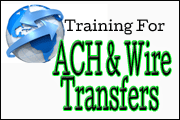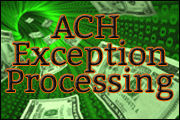ACH And Wire Transfer Training Courses |
Best-Selling Training Courses:Instructor-Led: Webinars Instructor-Led: Webinars |
ACH / Wire Transfer Training CoursesFinancial Institution examiners are focusing more and more on ACH Compliance. As such, it is imperative that you comply with the NACHA ACH Operating Rules. Non-compliance can cost you not only money, but your reputation.
We provide ACH and Wire Transfer compliance training that is designed to provide you with the knowledge you need to comprehend the compliance requirements associated with processing ACH entries on a day-to-day basis.
What Are ACH Regulations?
ACH rules, established under NACHA, set forth a reasonable set of performance guidelines that all ACH participants — like banks, credit unions, government organizations and more — must abide to ensure fair and efficient transactions and interactions.
It's a living document of sorts, as all qualified participants are allowed to suggest rule amendments, updates and revisions to better the system as a whole.
Why Is ACH Compliance Important?
First and foremost, failure to meet rules will likely result in legal challenges and fines that put a serious damper on your finances and reputation.
By following the rules set forth by NACHA and the ACH Network, you will stay in lockstep with the rest of your competition. You'll ensure you execute reliable, efficient payments, and you'll also improve your risk management practices while reducing returns and exceptions.
Also, understanding the rules and complying with them will give you better insight into how you can leverage the ACH Network to create better opportunities. Seeing as how frequently the rules change, you'll be prepared for upcoming changes, as well.
What You'll Learn From Our ACH and Wire Transfer Training Courses:
Our courses and seminars strive to cover all the bases while remaining accessible and easy to understand. Some advantages to taking our classes include:- Examine the bodies of law associated with each aspect of processing ACH entries, including the NACHA ACH Rules
- Regulation E, and UCC4A
- Understand how compliance plays a role in the processing of ACH government entries
- Examine the role compliance plays in overall risk management

- Discover the impact that compliance has in providing superior customer service
- Clarify how compliance improves overall operational effectiveness
- Ways to identify exceptions as an RDFI and ODFI and determine the best course of action
- Understanding the timeframes for exception processing
- Understanding of the new ACH Rules that impact exceptions
- Best practices for limiting your liability
- An understanding of the importance of using the correct return and NOC code
Find ACH and Wire Transfer Training CoursesTo find your desired ACH and Wire Transfer training courses, either select a Recommended Course from the list below, or select "ACH / Wire Transfer" and your state from the "Professional Development" section of the search box at the bottom of this page. If you have additional questions, feel free to contact us by filling out our online "Contact Us" form. |
Best-Selling Training Courses:Instructor-Led: Webinars Instructor-Led: Webinars |
Find Seminars, Webinars, And Online Training In Your Area |
More About ACHWhat's the History of ACH Origination?Beginning in California, the first ACH association formed in 1972 as an automated payment method to supplant physical checks, as concerned mounted about the sheer amount of checks getting cleared through payrolls. Many regional associates formed, but regulations were difficult to synchronize. That led to the formation of NACHA a few years later in 1974. Since then, this administrator of the ACH Network has created broadly adapted payment and financial messaging rules and regulations. How Does ACH Payment Processing Work?The ACH has fully embraced the shift to efficient electronic processing, as it allows people to complete batch movements with a store-and-forward system. On average, the ACH Networks moves about $43 trillion and 25 billion electronic financial transactions per year. Understanding precisely how the network works will leave the user better prepared to take advantage of its many benefits. In collaboration with NACHA, the ACH has established clear roles and responsibilities for various participants: - An Originator — which can be an individual, corporation or another entity — begins the transaction through entering a direct deposit or direct payment through the ACH Network. ACH transactions will classify either as debit or credit payments, and they can cover a vast range of categories that include, but are not limited to, online banking payments, mortgage and bill payments, direct deposit of payroll, government and Social Security benefits and B2B payments
- ACH entries are entirely electronic. It forgoes paper checks when entering and transmitting information, which drastically increases the level of security and convenience
- The requested transaction must go through the Originating Depository Financial institution (ODFI), which officially enters the Originator's ACH entry
- The ODFI does not complete submitted payments individually. Instead, the organization gathers various payments from their customers and then transmits them en masse at regular, predetermined intervals to an ACH Operator
- The next vital roleplayer in this process, an ACH Operator, falls under one of two umbrellas: The Federal Reserve or The Clearing House. These central clearing facilities receive the ODFI-sent batches
- Once they're distributed to the appropriate channel, ACH transactions are then categorized by the ACH Operator, who then makes them available to the Receiving Depository Financial Institution (RDFI)
- The RDFI officially completes the pending transaction. They will ensure that the Receiver's account is debited or credited in accordance with the ACH entry. As is true with Originators, Receivers can be businesses, individuals and other entities
- The rules state the ACH credit transaction must settle in one to two business days. Each debit transaction will settle in one business day
|
Share on Facebook
Share on Twitter |




